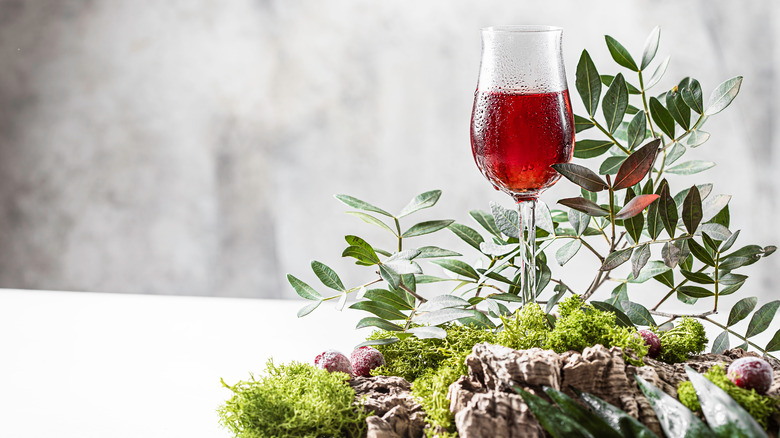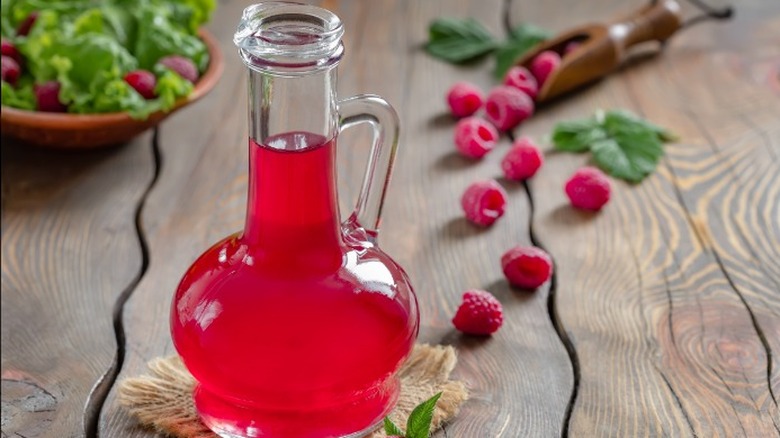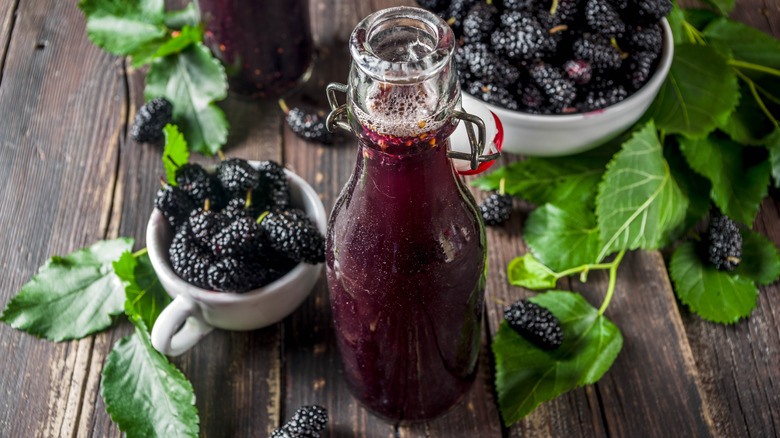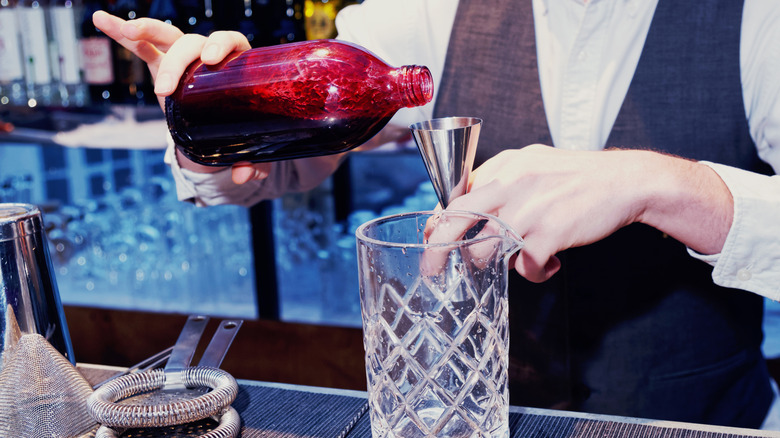What Is A Cocktail Shrub? (Hint: It's Not A Leafy Decoration)
In the cocktail world, the highest compliment isn't "This is delicious" — it's "This is balanced perfectly." A well-structured cocktail is what separates a decent home bartender from a world-class mixologist, and a major part of achieving that balance is acidity. Sometimes, the acidity comes from a lime wedge haphazardly slammed onto the rim of your glass during happy hour. However, other times, when you're embarking on a truly memorable cocktail voyage, that acid component is added with a little more intentionality. Enter: the shrub.
In a shrub, a produce base is macerated with sugar and combined with vinegar to form a tart syrup. Literally, it's drinking vinegar, but we don't mean balsamic. (Although, you can do that too, and frankly should give it a try.) "Shrub" comes from the Arabic "sharab," meaning "to drink," and it originated in 17th-century Britain. Shrubs arrived on U.S. shores with English settlers (who, in addition to enduring a harsh colonial New England winter, were also apparently cranking out killer cocktails). Per popular lore, it was invented as a method of preserving fruit before the advent of refrigeration. Today, making a shrub remains a good way to use up softened, bruised, overripe produce that might've seen better days. But, shrubs don't just have to be made from fruits: They can also be infused with fresh herbs, peppers, vegetables, or even flowers. As such, they're totally ABV-free.
So, why would anybody want to add a shrub to their cocktail?
Getting the whole drinking vinegar thing right
Admittedly, the idea of sweetened vinegar in your Martini glass might seem pretty unappetizing. So, why does it work? The combination of sugar and acid acts as a frame for showcasing the unique flavors of whatever ingredients you've used to make your shrub. In other words, sugar and vinegar are "nature's highlighter," making strawberries extra fruity and chiles extra peppery. Shrubs can be delicious, but admittedly, you're literally drinking vinegar, which has the potential to be super gross if executed poorly. That's why it's important to pick the right ingredients for the job.
Stay away from distilled white vinegar, which has a harsh flavor that evokes "pickling" or "cleaning supplies" — neither of which belongs anywhere near your cocktail. Robust red wine vinegar pairs well with berries or other heartier fruits, like plums, cherries, or black currants. Apple cider vinegar imparts a natural funk, which can be pleasant in apple, pear, or vegetable shrubs with a more savory profile. For shrubs made from delicate fruit and any type of fresh herb, California-based shrub-maker Dafna Kory recommends using a mild white wine vinegar (via The New York Times). But, shrubs (like most ingredients in the cocktail world) are separated by nuanced differences; play around with different flavor combos and see what works.
The hot and cold methods of shrub-making
There are two methods of making a knockout shrub: hot and cold. For both methods, it's the same wicked-simple, easy-to-remember recipe: equal parts produce, vinegar, and sugar.
In the hot method, vinegar is heated on the stovetop to remove any bacteria. (If a pathogen is dumped into the batch with your fermenting produce, it's bad news.) Then, the clean, heated vinegar is poured over your produce in a glass jar and left to ferment for a few days. Strain, add in the sugar, and you've got a hot-processed shrub ready to use. This method creates a deeper caramelized flavor; use it for sturdier fruits and vegetables.
The cold method keeps the brightness of the produce intact but takes longer to complete. It's a better option for more delicate ingredients, like peaches, pears, or any fresh herb. To do it, combine all three ingredients in a glass jar. Then, simply screw the lid on and place the jar in the fridge for roughly 48 hours, but no fewer than 24. (The longer it sits, the stronger it'll get.) To help it combine, give the jar a good shake from time to time.
Acidity acts as a natural preservative, which means in a refrigerated airtight container, your shrub should keep for months. But, as such, your shrub's shelf life is directly connected to the ingredients you choose to use. (For instance, a celery shrub probably won't hold up as long as a more acidic cranberry shrub.)
Shrub your way to a killer cocktail
This is the fun part. As you would when building any cocktail, pick a shrub flavor that naturally complements the undertones of the liquor base. For instance, whisky and bourbon pair well with apple shrubs, while sweet-bitter fig and pomegranate complement rum. Just steer clear of lemon, lime, and grapefruit — shrubs are already acidic enough on their own.
Once you've picked a base, the only limit is your imagination. This Spicy Jalapeño Shrub Cocktail recipe turns up the heat (the leftover shrub would be great stirred into a Bloody Mary or a Mojito). Rock your next girls' night with this earthy mescal cocktail with a carrot-cardamom shrub. Muddle a cucumber-peppercorn shrub into a savory G&T. Amp up vodka on the rocks with a shrub made from cranberry and a fresh ginger knuckle. Use apple-cinnamon shrub in a Hot Toddy, or simply stir it into bourbon and garnish with an orange wheel. If spirit-forward cocktails aren't your thing, you could add a splash of strawberry shrub to a Tequila Sunrise, or stir an apple-pear shrub into a glass of prosecco. For a quick and easy non-alcoholic cocktail, stir some shrub into a glass of soda water or ginger ale and add a few drops of bitters.
Keep in mind that a little shrub goes a long way, and add it sparingly as you assemble your cocktail. Start with 1 ounce of shrub per cocktail and add more to taste.



